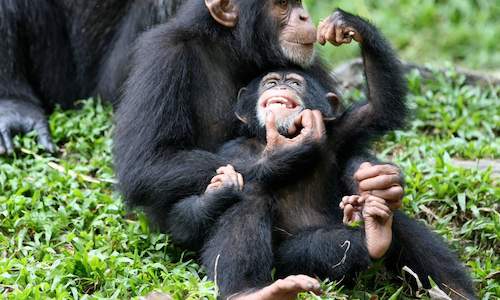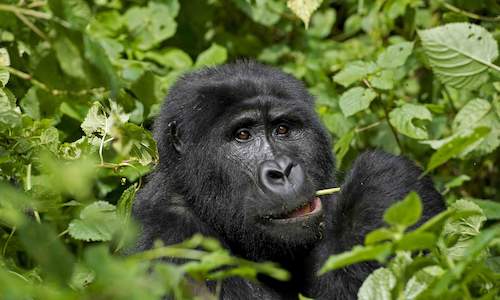Jane Goodall
Dr. Jane Goodall is one of the most prominent conservationists in the world. Her work among Chimpanzees in Tanzania transformed our understanding of them and ourselves.Early life
As a young child Dr. Jane Goodall dreamed about living among the animals of Africa. When she was 22 she received an invitation to stay with her friend in Kenya. She earned money as a waitress to pay for her passage to Africa. She arrived on the second of April 1957. Within a few weeks she met Louis Leakey, the famed archaeologist and palaeontologist. Leakey was taken by Jane's enthusiasm and hired her as an assistant.
Leakey reasoned that knowledge about the little understood Chimpanzee's could provide clues to our own evolutionary past. He asked Jane to undertake a study on a group of Chimpanzee's living on the shores of Lake Tanzania. In July 1960, Jane stepped onto the beach at Gombe accompanied by her mother to satisfy the British authorities who did not want a young woman living alone in the jungle.
Changing our understanding of Chimpanzees
Jane found her first weeks in Gombe frustrating as the Chimpanzee's fled whenever they saw her. One day she found a good vantage point from which she could watch the Chimps from a distance. Her research provided some startling insights into primate behaviour.
Omnivores
One day from a distance she observed a Chimpanzee which she called David Greybeard feeding on a baby bush pig. Jane would later observe Chimps actively hunting. Up until this point it had been assumed that Chimps were solely vegetarian. Just two weeks later she was hiking up a peak when she saw a Chimp in the undergrowth - David at a termite mound. He was using a long flexible probe to fish termites out of the mound. Jane constructed a hide so that she could observe the Chimps when they came again.
Tools
She later watched as they took twigs and stripped all the leaves off them to create a simple tool which they used to fish out the termites. This was a turning point in our understanding of primates. Up until this point tool making was used as a defining point to separate mankind from animals, but with this new discovery our understanding of Chimps, tools and mankind were redefined.
Leakey was ecstatic with Jane's findings and arranged for funding and for Jane who had no degree to enrol at the Cambridge University as a doctoral student. Jane then returned to her research at Gombe. She discovered that Chimps are individuals and have distinct personalities, an idea that was against the grain of ethnology at the time. Jane insisted on giving her Chimps names rather than numbers in her research which was unheard of at the time.
Throughout her years of studying Chimpanzee behaviour, which has spanned over 45 years, Jane has developed an understanding of Chimpanzee society and is considered to be the foremost expert in the field. Jane's observations were published in National Geographic with captivating photos by photographer Hugo van Lawick, who became Jane's first husband. This increased support and funding for the Gombe study and the Gombe Stream Research Centre was founded.
Complex social behaviour of Chimps
In the 1970's Jane observed the darker side of Chimps nature when conflict erupted between rival Chimp groups and a Chimp called Figan lead his troop into war and killed all seven of the rival males and a female. The females also exhibited disturbing behaviour. They killed and ate between 5 and 10 newborn infants. Although such brutality is disturbing Jane also speaks about the altruism of the Chimps. Two orphaned Chimps were taken in by two older male Chimps who were themselves orphans.
An expanded mandate - conservation education
Over the years the Gombe Stream Research Centre grew and Jane and her fellow researchers looked at Chimpanzee feeding behaviour, ecology, infant development and aggression. Jane started to travel widely promoting conservation though she continues to return to Gombe. Her book The Chimpanzees of Gome: Patterns of Behaviour was published in 1986. At a conference in Chicago to celebrate the books launch many Chimp biologists came together and realised how widespread and urgent the threats facing Chimps were.
For Jane the message was clear "We understand chimps much better now. They are more like us than we ever imagined. But now we must help save them. Jane had gone into the conference as a scientist. She left as an activist, determined to save the amazing creatures who she knew so well."
Today Jane is on the road more than 300 days per year. At any given time, she could be on any continent. On any given day, she could be speaking to a group of students, meeting with government officials to discuss conservation issues, sitting before television cameras being interviewed, or meeting with donors to raise money for JGI.
Jane continues to work tirelessly for the conservation and protection of the Chimps and their habitat. It's more than that though; Jane especially works with children, teaching them about conservation and how to create a better world. Jane is in great demand and known as an inspirational speaker.

Experience the amazing wildlife of Africa. Go on some exciting game drives and forest walks Witness gorillas in their natural environment an...
more
The Sceintific name for the Mountain Gorilla is Gorilla beringei beringei. Remarkably strong, the mountain gorilla has a short trunk and a b...
more
